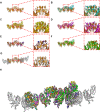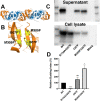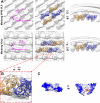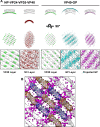Ebola and Marburg virus matrix layers are locally ordered assemblies of VP40 dimers
- PMID: 33016878
- PMCID: PMC7588233
- DOI: 10.7554/eLife.59225
Ebola and Marburg virus matrix layers are locally ordered assemblies of VP40 dimers
Abstract
Filoviruses such as Ebola and Marburg virus bud from the host membrane as enveloped virions. This process is achieved by the matrix protein VP40. When expressed alone, VP40 induces budding of filamentous virus-like particles, suggesting that localization to the plasma membrane, oligomerization into a matrix layer, and generation of membrane curvature are intrinsic properties of VP40. There has been no direct information on the structure of VP40 matrix layers within viruses or virus-like particles. We present structures of Ebola and Marburg VP40 matrix layers in intact virus-like particles, and within intact Marburg viruses. VP40 dimers assemble extended chains via C-terminal domain interactions. These chains stack to form 2D matrix lattices below the membrane surface. These lattices form a patchwork assembly across the membrane and suggesting that assembly may begin at multiple points. Our observations define the structure and arrangement of the matrix protein layer that mediates formation of filovirus particles.
Keywords: Ebola virus; Marburg virus; infectious disease; matrix protein; microbiology; molecular biophysics; structural biology.
© 2020, Wan et al.
Conflict of interest statement
WW, MC, MN, LK, AK, ZB, SB, ES, JB No competing interests declared
Figures














Similar articles
-
Lipid-specific oligomerization of the Marburg virus matrix protein VP40 is regulated by two distinct interfaces for virion assembly.J Biol Chem. 2021 Jan-Jun;296:100796. doi: 10.1016/j.jbc.2021.100796. Epub 2021 May 18. J Biol Chem. 2021. PMID: 34019871 Free PMC article.
-
Ubiquitin Ligase SMURF2 Interacts with Filovirus VP40 and Promotes Egress of VP40 VLPs.Viruses. 2021 Feb 12;13(2):288. doi: 10.3390/v13020288. Viruses. 2021. PMID: 33673144 Free PMC article.
-
Crystal Structure of Marburg Virus VP40 Reveals a Broad, Basic Patch for Matrix Assembly and a Requirement of the N-Terminal Domain for Immunosuppression.J Virol. 2015 Dec 9;90(4):1839-48. doi: 10.1128/JVI.01597-15. Print 2016 Feb 15. J Virol. 2015. PMID: 26656687 Free PMC article.
-
Host and Viral Proteins Modulating Ebola and Marburg Virus Egress.Viruses. 2019 Jan 3;11(1):25. doi: 10.3390/v11010025. Viruses. 2019. PMID: 30609802 Free PMC article. Review.
-
Membrane binding and bending in Ebola VP40 assembly and egress.Front Microbiol. 2014 Jun 18;5:300. doi: 10.3389/fmicb.2014.00300. eCollection 2014. Front Microbiol. 2014. PMID: 24995005 Free PMC article. Review.
Cited by
-
Mechanisms of phosphatidylserine influence on viral production: A computational model of Ebola virus matrix protein assembly.J Biol Chem. 2022 Jul;298(7):102025. doi: 10.1016/j.jbc.2022.102025. Epub 2022 May 11. J Biol Chem. 2022. PMID: 35568195 Free PMC article.
-
Computational and experimental identification of keystone interactions in Ebola virus matrix protein VP40 dimer formation.Protein Sci. 2024 May;33(5):e4978. doi: 10.1002/pro.4978. Protein Sci. 2024. PMID: 38591637 Free PMC article.
-
Anti-Ebola virus mAb 3A6 protects highly viremic animals from fatal outcome via binding GP(1,2) in a position elevated from the virion membrane.Nat Commun. 2025 Feb 3;16(1):1293. doi: 10.1038/s41467-025-56452-2. Nat Commun. 2025. PMID: 39900911 Free PMC article.
-
Lipid-specific oligomerization of the Marburg virus matrix protein VP40 is regulated by two distinct interfaces for virion assembly.J Biol Chem. 2021 Jan-Jun;296:100796. doi: 10.1016/j.jbc.2021.100796. Epub 2021 May 18. J Biol Chem. 2021. PMID: 34019871 Free PMC article.
-
Negative-sense RNA viruses: An underexplored platform for examining virus-host lipid interactions.Mol Biol Cell. 2021 Oct 1;32(20):pe1. doi: 10.1091/mbc.E19-09-0490. Mol Biol Cell. 2021. PMID: 34570653 Free PMC article. Review.
References
-
- Adams PD, Afonine PV, Bunkóczi G, Chen VB, Davis IW, Echols N, Headd JJ, Hung LW, Kapral GJ, Grosse-Kunstleve RW, McCoy AJ, Moriarty NW, Oeffner R, Read RJ, Richardson DC, Richardson JS, Terwilliger TC, Zwart PH. PHENIX: a comprehensive Python-based system for macromolecular structure solution. Acta Crystallographica Section D Biological Crystallography. 2010;66:213–221. doi: 10.1107/S0907444909052925. - DOI - PMC - PubMed
-
- Adu-Gyamfi E, Soni SP, Xue Y, Digman MA, Gratton E, Stahelin RV. The ebola virus matrix protein penetrates into the plasma membrane: a key step in viral protein 40 (VP40) oligomerization and viral egress. The Journal of Biological Chemistry. 2013;288:5779–5789. doi: 10.1074/jbc.M112.443960. - DOI - PMC - PubMed
Publication types
MeSH terms
Substances
Grants and funding
LinkOut - more resources
Full Text Sources
Medical

